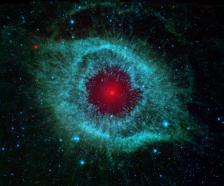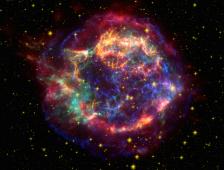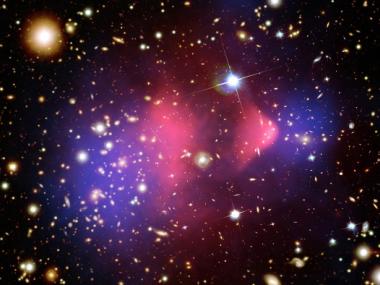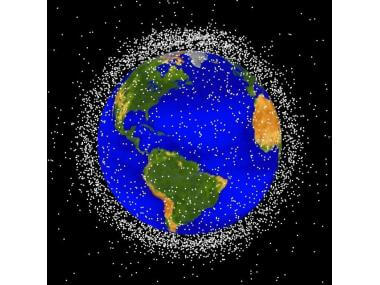Will the Sun Explode?
Will our Sun explode? Does every star end in a supernova? How are black holes formed? Ask Science explores the science behind the stars.
Hi, I’m Dr. Sabrina Stierwalt, your Ask Science, bringing you Quick and Dirty Tips to help you make sense of science.
We rely on our Sun to keep us warm and we trust that every night when we go to bed, the Sun will rise again the next morning to light up our day. However, the Sun won’t do this forever. What will happen to our Sun as it ages? Will it explode? How soon?
Find books, apps, merch and more from your favorite Quick and Dirty Tips hosts at quickanddirtytips store.
A Day in the Life of Our Sun
Our Sun is one of 300 billion stars in our galaxy, the Milky Way. These stars are born out of collapsing clouds of gas. As a gas cloud contracts, or collapses under the weight of its own gravity, the atoms in the cloud have less and less room to move around. This causes the pressure and temperature inside the cloud increase.
Once the pressure is high enough to ignite hydrogen burning, the newborn stars will “turn on,” or start converting hydrogen atoms into helium. The leftover energy generated by this process is released in the form of photons, or light.
As these photons fight their way out of the core, they exert their own pressure outward against gravity (called radiation pressure), which acts to prevent the cloud’s collapse. Once these photons make it to the star’s surface and are released, the star begins to shine. Most of the stars in the universe are currently in this hydrogen burning phase.
Photons leaving our Sun do not arrive instantaneously on Earth, but instead, travel at the finite speed of light. That travel time is roughly 8 minutes. So if a super villain threw an enormous, heat-resistant blanket over the Sun, we would live in blissful unawareness for long enough to make ourselves one last sandwich (or listen to an Ask Science podcast!).
Eventually, after 10 billion years or so, depending on how big the star was initially, the star will run out of hydrogen in its core to burn. Our Sun is about half way through its hydrogen burning phase. This means it has enough fuel for about another 4.5-5 billion years.
Red Giant Stars
Once a star like our Sun exhausts the hydrogen in its core, the core will start to contract again. Except this time, there won’t be any radiation pressure to balance the gravity. During this core contraction stage, the temperature and pressure in the core increase again.
The star also burns the hydrogen in the layers surrounding the core, a process that heats the star’s outermost layers. These heated outer layers expand, causing the overall size of the star to increase.
The now larger, puffier star has a lower surface temperature (since the same amount of heat is now spread out over a larger surface), and thus appears reddened. Stars in this phase of their evolution are dubbed “red giant stars,” and their puffy, poorly-defined outer edges give them a fuzzy appearance.
Red giant stars are roughly 20-100 times the size of our Sun. When the Sun reaches the red giant phase, it will become so large that it will swallow Mercury and Venus! Astronomers disagree on whether our future red giant Sun will also engulf the Earth or just become dangerously close. Either way, we won’t be able to live here anymore.
Meanwhile, back in the red giant star’s core, which is still contracting, the temperature and pressure eventually get so high that the star begins to burn the next heaviest element—helium. Sometimes this happens in a burst of energy called a helium flash. The red giant phase only lasts for about a billion years or so before helium sparks—a relatively short time for stellar evolution.
Going Out with a Bang

Massive stars will move through the periodic table until they start making iron, the heaviest element that can be fused without requiring the input of additional energy. Iron cores are ultimately unstable and result in huge, fast explosions called supernovae.
See also: A Tour of the Periodic Table Part I, Part II, and Part III.
One supernova can shine brighter than the light of 100 billion stars combined. Based on the number of massive stars in our galaxy, as well as the length of a star’s life before it reaches the iron core phase, we expect a supernova to happen once every 100 years. Have you seen one yet?
Small, low mass stars, like our Sun, will never get hot enough in their cores to burn any elements past helium. Their outer layers, the stuff that got puffed up during the red giant phase, get blown off due to strong winds. This ionized gas then forms beautiful rings around the star, which are called planetary nebula, even though they are unrelated to planets.
Once its helium fuel is exhausted, our Sun will become what is called a white dwarf star, no longer capable of generating energy. These stars are so dense that one teaspoon of white dwarf weighs 5.5 tons—that’s as much as an elephant here on Earth!
Even though they aren’t creating energy through fusion, white dwarfs can still emit light. All those photons produced in the core continue to fight their way to the surface, a process that can take hundreds of billions of years.
Eventually, the white dwarf will run out of energy, leaving behind a dense, dark core called a black dwarf. However, the universe is not more than 14 billion years old, so there are no stars that have been around long enough to have evolved into black dwarfs…yet.
White dwarfs still have a chance to go supernova if they are in a binary system—or in other words, if they rotate around a shared center of mass with another star. If a very dense white dwarf pulls material off of a nearby neighbor, eventually the weight of that added gravity will be too much for the star to support.
The heaviest mass a white dwarf star can support is 1.4 times the mass of our Sun—a limit astronomers call the Chandrasekhar limit. This is the difference between going out with a bang or a whimper. Once a white dwarf exceeds this limit, a sort of runaway reaction occurs as all of the star’s material collapses in a matter of seconds resulting in a violent supernova explosion.
Supernovae are extremely important to life as we know it for two reasons.
- All of the elements fused in the cores of stars would remain locked there forever, and of no use to us, if not for supernova explosions sending them out into space.
- We mentioned that elements on the periodic table beyond iron cannot be fused in stars, since such reactions require energy rather than produce it. Elements heavier than iron are formed thanks to the high speed collisions of other atoms, a byproduct of high energy supernova explosions. As the astronomer Carl Sagan once famously said, “We are all made of star stuff.”
How Are Black Holes Formed?
If a star is massive enough at the beginning of its life, more than 20 times more massive than our Sun, the core left behind after a supernova will be massive enough to form a black hole. Black holes are stellar cores so dense that not even light can escape. Anything entering the surface of the black hole, known as the event horizon, will be trapped there forever.
Did you know that many of the Quick and Dirty Tips hosts are bestselling authors? Check out the whole selection of books, apps, events, and gear at quickanddirtytips.com/store. That’s quickanddirtytips.com/store.
Have any questions or comments about our Sun or stars in general? Ask them in the comments below or on Facebook QDTEinstein.
Once again, I’m Sabrina Stierwalt, the Ask Science, helping you make sense of science!
Images from nasa.gov








